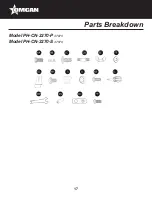
13
Operation
Before performing a leak test, be sure that no sparks can occur and you are in a spacious outdoor area.
Connect the propane gas tank to the regulator and turn the valve on the unit to the “off” position. Brush a soap
and water mixture on all connections. Turn the gas supply on; if bubbles occur on any connection there may be
a leak. If you smell gas or a leak is discovered turn the gas valve off, disconnect propane gas tank and do not
use the appliance until the leak is repaired.
Do not use the heating unit without inspecting the gas hose. If there are signs of wear or abrasion you must
replace the hose (if applicable).
TO TURN THE HEATER ON
WARNING: Please ensure the glass tube has not been damaged before operation.
1. Ensure the variable control knob is at the OFF position.
2. Connect the gas regulator to a compatible gas cylinder.
3. Push and turn the variable control knob to the “Pilot” position and hold for 60 seconds. Whilst still holding
the control knob down, press the ignition button. A pilot flame should appear.
4. Once the blue pilot flame stays alight constantly, let go of the variable knob.
5. Turn the variable control knob to the desired temperature position – Lo to Hi
IMPORTANT NOTE
• When lighting the heater for the first time or a new cylinder is connected, the air inside the hose must be
purged. This process will take a few minutes as liquefied petroleum gas is heavier than air.
• As a result the variable control knob should be pressed down at the Pilot position for 3 Minutes instead of
the normal 60 second period.
• This ensures the gas purges the air in the hose and passes from the cylinder through to the main burner.
TO TURN THE HEATER OFF
1. Turn the variable control to the PILOT position.
2. Push and turn the variable control knob to the OFF position.
3. Turn the regulator connected to the gas cylinder to the OFF position.
Maintenance
• Before performing any maintenance always disconnect propane gas tank.
• Keep the heating item free and clear from combustible materials.
• Visually inspect burner for obstructions and keep tank enclosure free and clear from debris.
• Use a soft brush to get rid of the mild stains, loose dirt and soil after the burner is completely cooled down.
Wipe down with a soft cloth.
• Harsh weather conditions may cause stubborn stains, discoloration and possibly rust pitting.
• Permanent damage may occur if powder or solvent comes in contact with painted or plastic components on






































